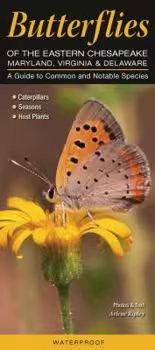Arlene Ripley’s “Butterflies of the Eastern Chesapeake: Maryland, Virginia & Delaware” is a commendable, if somewhat uneven, attempt to capture the lepidopteran diversity of a region rich in both natural beauty and ecological complexity. It serves as a useful introduction for novice to intermediate enthusiasts, but its limitations prevent it from becoming a definitive guide.
Ripley’s strength lies in her clear and accessible writing style. She avoids overly technical jargon, opting for straightforward descriptions that make the book approachable for a broad audience. This is particularly beneficial for those new to butterfly identification, allowing them to grasp key distinguishing features without feeling overwhelmed.
The species accounts, which form the core of the book, are generally informative. Ripley provides essential details on habitat preferences, flight periods, and larval host plants, crucial elements for understanding the butterflies’ ecological roles. The inclusion of photographs is a significant asset, enabling visual confirmation of species identification. However, the quality and consistency of these images vary, with some being more helpful than others.
The book’s focus on “common and notable species,” while understandable for a regional guide, inevitably leads to omissions. Several less conspicuous, but ecologically significant, species are excluded. While this selectivity may be justified for a beginner’s guide, it limits the book’s value as a comprehensive reference.
Furthermore, the depth of information provided varies somewhat between species. Some accounts are detailed and insightful, while others are rather cursory, lacking in-depth information on life cycles or behavioral patterns. This inconsistency diminishes the book’s value as a consistent and reliable resource.
The book’s organization is logical, adhering to standard taxonomic classifications. However, the absence of a comprehensive index can make it challenging to locate specific species quickly, particularly in the field. This is a significant drawback for a field guide, where rapid access to information is often crucial.
The book’s treatment of ecological relationships is also somewhat limited. While Ripley acknowledges the importance of habitat conservation and the role of butterflies as pollinators, she fails to delve into the intricate interactions between butterflies and their environment. The book would have benefited greatly from a more thorough exploration of the ecological roles of butterflies, as well as the impact of human activities on their populations.
The book’s regional scope, while its primary focus, also limits it. The lack of broader comparative analyses, contrasting the butterfly fauna of the Eastern Chesapeake with that of other regions, limits the reader’s ability to draw universal conclusions about butterfly ecology and distribution.
In conclusion, “Butterflies of the Eastern Chesapeake” is a serviceable guide for identifying common and notable species within the tri-state area. Its clear writing style and useful photographs make it a helpful tool for novice enthusiasts. However, its limited scope, uneven species accounts, and superficial treatment of ecological relationships prevent it from achieving its full potential. While it may serve as a helpful introduction to the region’s butterfly fauna, more comprehensive resources are needed for in-depth study.





Reviews
There are no reviews yet.